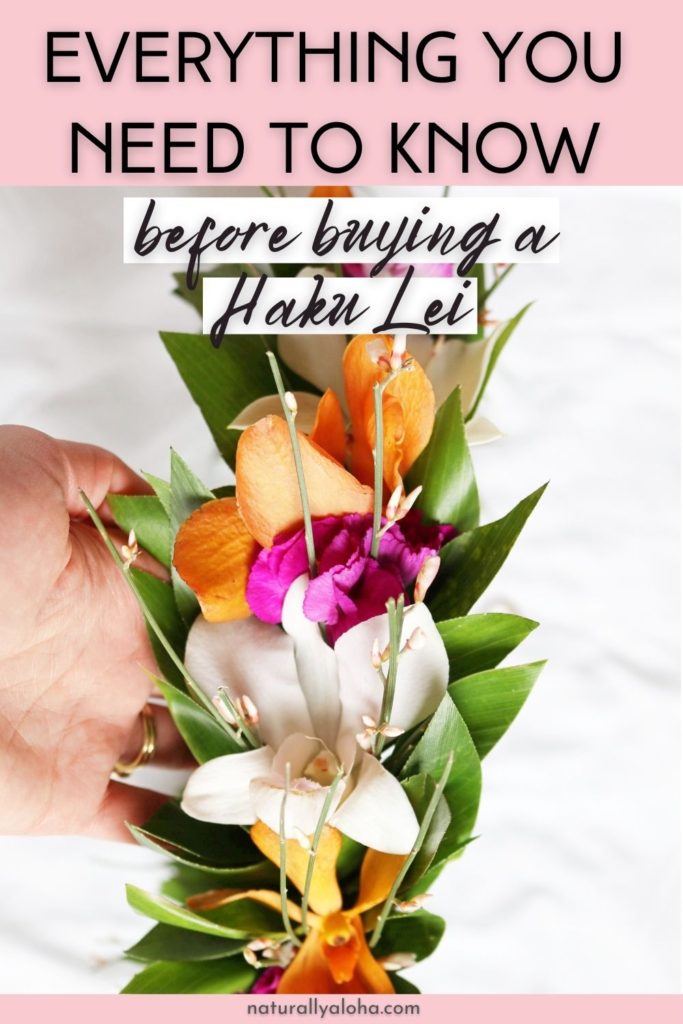
A haku lei makes any trip to Hawaii that much better! We’ve all seen the touristy pictures of people in Hawaii, purple orchid leis around their necks, donning colorful aloha shirts, and big smiles on their faces. But what if you could experience more than the touristy stuff in Hawaii? What if you could wear more than a lei to explore Hawaii, and feel a natural grace and elegance that blends in with the vibe of the refreshing islands?
This is exactly what a haku lei can do. This all-natural (or synthetic, if you choose!) accessory is more than just a flower crown.
The traditional art of making a lei po’o, aka a “lei” for the “po’o” (head), has been practiced for hundreds of years. We use lei po’o for celebrations, hula dance, birthdays, or just because!
There are different ways to make the lei po’o, which is why not all lei po’o are considered haku lei, the popular term these lovely crowns have been given in the last couple of years.
What is your lei po’o style?
Here is a brief list of the different style of lei po’o to help you get a feel for the type you want:
Kui – This style is mostly used to make the lei that hangs around the neck. However, it can also be used to make lei po’o. A long lei needle strings the flowers together. The strings are then tied together, making a beautiful lei. The flowers that make up a kui lei are usually plumeria, orchid, pua kenikeni, tuberose, and carnations.
Wili – Wili means “to twist.” This is the most popular style to make lei po’o. A strand of raffia or ti leaf secures flowers and ferns to a backing. Many people refer to this as a haku lei, but we’ll get to that next!

Haku – Lei haku is actually a braided or woven lei, where flowers and/or ferns are braided or woven to keep in place. I’ve seen this style mostly used by hula dancers, as they braid ti leaves or other ferns to keep firmly in place.
So what is a haku lei?
A haku lei is actually the “weaver of lei” and the lei haku is the braided/woven lei. At this point, people find it easier to refer to the haku lei as the reference to a lei po’o. If you want to be specific, though, that’s great!
Where can I get a lei po’o in Hawaii?
One of my favorite haku lei artists is Andrea from petite.maui, who I partnered with for this blog post. Located on the island of Maui, Andrea creates any style of lei po’o you want. From bold foliage that pops, to pastels and whites for special occasions, she can make it all.
There are quite a few lei po’o makers in Hawaii, but it’s important to know what makes a good lei maker. Here are a few tips to help you find a great head lei for your trip to Hawaii!
What makes a good haku lei?
The style is clean
My mom worked and competed as a professional hula dancer growing up, and she told me few things about what makes the best lei po’o. The first thing she told me is that the style is clean, no matter if it’s a wili, kui, or haku style. When I look at haku lei maker’s work, I pay attention to the inside. That seems weird because doesn’t it only matter what the outside looks like?
The inside is what touches your head and if it’s not quality work, it won’t feel good to wear. It will be uneven against your forehead, and it can hurt to wear.
Trust me, I’ve worn lei po’o that isn’t made well. Though they might look pretty, they really hurt and I want to take it off asap! It’s honestly a bummer!
As you can see in the picture below, Andrea’s haku lei has a clean wili style inside of the lei po’o. This makes it comfortable to wear, meaning you’ll never want to take it off! 🙂

The colors pop
Every artist and graphic designer can testify to the importance of colors. A lei po’o artist is no different than any other artist. They pay attention to color and theme, and especially make the lei po’o to the needs and wants of the person receiving it.
One thing I loved about Andrea’s work is I didn’t tell her specifically what I wanted, but she definitely over-delivered! She chose a simple style of white and orange orchids, complimented by magenta carnations and bold ti leaves. When she gave it to me, she said she chose some “playful colors,” which I loved.

Working with a local lei artist has great benefits: whatever colors and theme you desire, they’ll help you bring that vision to life.
The haku lei is made with aloha
If someone is going to make you something, it’s so important they make it with aloha. Andrea was so sweet and helpful, I could immediately tell the goodness she put into making the haku lei. While it might be easy to buy a haku lei from a shop in the city, it takes away from the heart and meaning of haku lei making. I’ve made haku lei before and it is truly a labor of love. It takes time and care to pick the flowers and ferns, assemble the foliage, and make the haku lei itself.
“Hana me ke aloha” is one of my favorite sayings meaning to “work with love.” Buying a lei po’o from a local artist can guarantee this amazing experience and connection.
Read more about the value of aloha: Aloha: Always Live with Love
Can I take my haku lei home?
Oftentimes you can, as long as your lei does not include specific plants that are prohibited. Refer to this website to see prohibited plants, and specifically ask your haku lei artist to not include those things.
Taking Leis from Hawaii to the U.S. Mainland
When you take it home, I suggest letting it dry and keeping it for the memories! The haku lei Andrea made was so beautiful and well-made, that I’m letting it dry to use as a decoration in the office! 🙂
Will you wear a haku lei on your next trip to Hawaii?
I love supporting local Hawaii artists, and haku lei makers are no exception. The malama and aloha that goes into creating a lei po’o can be felt every time you put it on. It makes a trip to Hawaii that much more special!
Check out Andrea’s beautiful work at petite.maui!
Let’s hear from you!
Let me know in the comments: What is your favorite Hawaiian flower?
For this post, I partnered with Andrea at petite.maui. You can count on me to be an honest and good steward of this opportunity. All opinions are my own.
Save this for later














